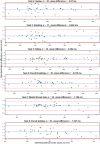Cross-instrument feasibility, validity, and reproducibility of wireless heart rate monitors: Novel opportunities for extended daily life monitoring
- PMID: 34286857
- PMCID: PMC10138748
- DOI: 10.1111/psyp.13898
Cross-instrument feasibility, validity, and reproducibility of wireless heart rate monitors: Novel opportunities for extended daily life monitoring
Abstract
Wired ambulatory monitoring of the electrocardiogram (ECG) is an established method used by researchers and clinicians. Recently, a new generation of wireless, compact, and relatively inexpensive heart rate monitors have become available. However, before these monitors can be used in scientific research and clinical practice, their feasibility, validity, and reproducibility characteristics have to be investigated. Therefore, we tested how two wireless heart rate monitors (i.e., the Ithlete photoplethysmography (PPG) finger sensor and the Cortrium C3 ECG monitor perform against an established wired reference method (the VU-AMS ambulatory ECG monitor). Monitors were tested on cross-instrument and test-retest reproducibility in a controlled laboratory setting, while feasibility was evaluated in protocolled ambulatory settings at home. We found that the Cortrium and the Ithlete monitors showed acceptable agreement with the VU-AMS reference in laboratory setting. In ambulatory settings, assessments were feasible with both wireless devices although more valid data were obtained with the Cortrium than with the Ithlete. We conclude that both monitors have their merits under controlled laboratory settings where motion artefacts are minimized and stationarity of the ECG signal is optimized by design. These findings are promising for long-term ambulatory ECG measurements, although more research is needed to test whether the wireless devices' feasibility, validity, and reproducibility characteristics also hold in unprotocolled daily life settings with natural variations in posture and activities.
Keywords: adolescents; cardiovascular; heart rate; heart rate variability.
© 2021 Society for Psychophysiological Research.
Conflict of interest statement
The authors declare that there is no conflict of interest.
Figures



Similar articles
-
From lab to life: Evaluating the reliability and validity of psychophysiological data from wearable devices in laboratory and ambulatory settings.Behav Res Methods. 2024 Oct;56(7):1-20. doi: 10.3758/s13428-024-02387-3. Epub 2024 Mar 25. Behav Res Methods. 2024. PMID: 38528248
-
Reliability and validity of TIPS wireless ECG prototypes.Stud Health Technol Inform. 2012;181:83-7. Stud Health Technol Inform. 2012. PMID: 22954833
-
[Low-power Wireless Micro Ambulatory Electrocardiogram Node].Sheng Wu Yi Xue Gong Cheng Xue Za Zhi. 2016 Feb;33(1):8-13. Sheng Wu Yi Xue Gong Cheng Xue Za Zhi. 2016. PMID: 27382732 Chinese.
-
Heart rate monitors: state of the art.J Sports Sci. 1998 Jan;16 Suppl:S3-7. doi: 10.1080/026404198366920. J Sports Sci. 1998. PMID: 22587712 Review.
-
The Telltale Heartbeat: Heart-Rate Monitors are Taking New Shapes.IEEE Pulse. 2016 Jan-Feb;7(1):35-8. doi: 10.1109/MPUL.2015.2498466. IEEE Pulse. 2016. PMID: 26799726 Review.
Cited by
-
A Real-Time Evaluation Algorithm for Noncontact Heart Rate Variability Monitoring.Sensors (Basel). 2023 Jul 26;23(15):6681. doi: 10.3390/s23156681. Sensors (Basel). 2023. PMID: 37571465 Free PMC article.
-
Test-Retest Reliability and Concurrent Validity of Photoplethysmography Finger Sensor to Collect Measures of Heart Rate Variability.Sports (Basel). 2025 Jan 22;13(2):29. doi: 10.3390/sports13020029. Sports (Basel). 2025. PMID: 39997960 Free PMC article.
-
Digital biomarkers for non-motor symptoms in Parkinson's disease: the state of the art.NPJ Digit Med. 2024 Jul 11;7(1):186. doi: 10.1038/s41746-024-01144-2. NPJ Digit Med. 2024. PMID: 38992186 Free PMC article. Review.
-
Impact of Outdoor Play Structures on Moderate to Vigorous Physical Activity in Children during Recess: A Comparative Study.Children (Basel). 2024 Jul 7;11(7):828. doi: 10.3390/children11070828. Children (Basel). 2024. PMID: 39062277 Free PMC article.
-
From lab to life: Evaluating the reliability and validity of psychophysiological data from wearable devices in laboratory and ambulatory settings.Behav Res Methods. 2024 Oct;56(7):1-20. doi: 10.3758/s13428-024-02387-3. Epub 2024 Mar 25. Behav Res Methods. 2024. PMID: 38528248
References
-
- Cicchetti, D. V. (1994). Guidelines, criteria, and rules of thumb for evaluating normed and standardized assessment instruments in psychology. Psychological Assessment, 6(4), 284–290. 10.1037/1040-3590.6.4.284 - DOI
-
- Cortrium.com . (2019). https://www.cortrium.com
-
- Cullen, A. C. , & Frey, H. C. (1999). Probabilistic techniques in exposure assessment: A handbook for dealing with variability and uncertainty in models and inputs. Plenum Press.
Publication types
MeSH terms
LinkOut - more resources
Full Text Sources
Miscellaneous

